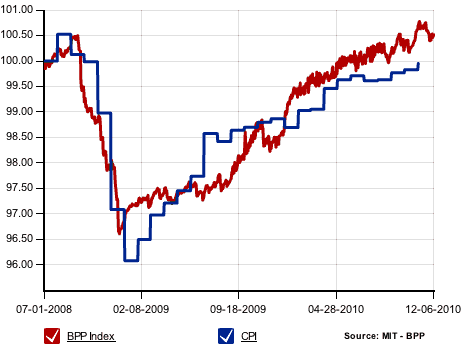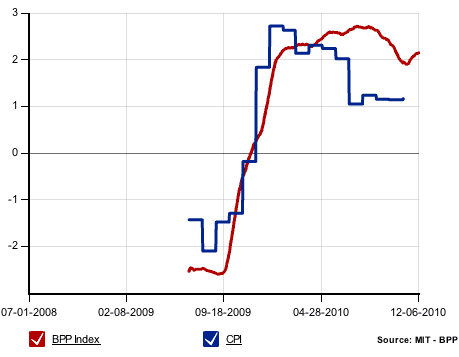A lot of people are worrying about inflation or deflation in the future. The most widely used definition of inflation is the Consumer Price Index, which is published monthly by the Bureau of Labor Statistics and is based on a basket of consumer goods using price surveys from cities around the country. This takes a while, so the CPI for December would be published in mid-January.
Professors Roberto Rigobon and Alberto Cavallo at the MIT Sloan School of Management started the Billion Prices Project which, directly pulls data from online retailers from around the world. In the US, the software is tracking 550,000 items from 53 retailers. The best part – since it’s all automated, the numbers are updated daily! The goal is to predict the CPI before they even announce it. You can see from the charts below that the two track reasonably well together.
Daily BPP Index vs. CPI

.
Annual Inflation (over last 365 days)

If they start to vary widely, which one should be considered inaccurate? Via the NY Times.
 The Best Credit Card Bonus Offers – 2025
The Best Credit Card Bonus Offers – 2025 Big List of Free Stocks from Brokerage Apps
Big List of Free Stocks from Brokerage Apps Best Interest Rates on Cash - 2025
Best Interest Rates on Cash - 2025 Free Credit Scores x 3 + Free Credit Monitoring
Free Credit Scores x 3 + Free Credit Monitoring Best No Fee 0% APR Balance Transfer Offers
Best No Fee 0% APR Balance Transfer Offers Little-Known Cellular Data Plans That Can Save Big Money
Little-Known Cellular Data Plans That Can Save Big Money How To Haggle Your Cable or Direct TV Bill
How To Haggle Your Cable or Direct TV Bill Big List of Free Consumer Data Reports (Credit, Rent, Work)
Big List of Free Consumer Data Reports (Credit, Rent, Work)
That’s interesting and I wasn’t aware of this measure. I wonder if their real intent is to predict CPI in advance and on a realtime basis or to improve upon CPI as a measure of inflation. CPI is driven by some factors like the housing market (owner’s equivalent rent) that don’t make it a great overall indicator of people’s true experience of rising or falling prices.
I don’t think there is one number you can associate with inflation that is valid for all economies/institutions/individuals. Accuracy would depend on which basket and weightings are closest to what you deem important. But it does look like BPP follows CPI fairly consistently. It does seem to trail CPI at local extrema though, so I wouldn’t be trading CPI futures on the CME with BPP.
This is interesting to see. Great post. Let’s see the effect in the next months.
I wonder if the inventory change much like the items in the “basket” used for CPI can change from sirloin to ground chuck?
Interesting. They are pretty close so far, but will probably diverge in the future. I wouldn’t take that to mean one is right and the other is wrong. They are different and use different methodology.
It looks like the MIT index only measures products for sale at retail online vendors. So it is limited to certain consumer goods. I don’t buy gas for my car, heat for my house or pay rent at Amazon. So the MIT index would probably be a great indicator of retail prices on consumer goods and foods, but probably useless for other things you don’t normally buy via the web.
I’d also be curious to see more about the details of what MIT is actually measuring. THey say they track 53 vendors but which ones are they? Amazon, Walmart, Bestbuy, etc? Just curious.
Thinking about it overnight, I think this would be cool if they could start allowing people create their own personalized inflation index to track.
@DaveD – CPI does use such hedonic adjustments to a certain degree:
http://www.bls.gov/cpi/cpihqaitem.htm
The BPP price index does not, according to their site.
@jim – I can’t find the retailer details right now either. Probably all of them, and then averaged together.
As for items, they appear to definitely track food prices using this method. Rent technically shouldn’t be that hard either, with sites like the rent-o-meter already up and running for a while.
Uncle Sam lies to us about inflation. It is a hidden tax against our wealth and purchasing power – and they take it without any voters ever approving it.
Check out shadowstats.com.
I can’t find the retailer details right now either. Probably all of them, and then averaged together
As mentioned by others if it doesn’t track some other items like power prices (which could be derived from some website like electric and gas companies), etc. it may be lacking in some large cost areas.
Others, myself included, do not see inflation or deflation as mutually exclusive so these types of metrics are only somewhat useful. The best ‘real’ inflation numbers I have found that seem to fit the ‘feel on the street’ is the SGS put out by http://www.shadowstats.com/. Would you still like to monitor M3? http://www.shadowstats.com/alternate_data/money-supply-charts
Sorry for the SGS plug and I have financial interest in John’s information but he has helped make me a bunch of $$ and I would like to see others benefit as well.